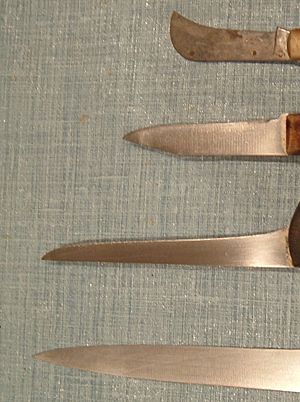Blade facts for kids
A blade is a flat, sharp part of a tool or weapon. It's designed to cut, slice, or stab. Think of the sharp edge of a knife, a sword, or even a razor. Most blades have a handle to help you hold and use them safely. Blades are used for many different tasks, from preparing food to building things. They come in all sorts of shapes, sizes, and are made from various materials.
Contents
What is a Blade?
A blade is a tool or part of a tool that has a sharp edge. This edge is made to cut, slice, or pierce objects. The sharpness of a blade allows it to apply a lot of pressure to a very small area. This makes it easy to separate or divide materials.
Blades are found on many common items. These include kitchen knives, scissors, and even the tiny blades in pencil sharpeners. They are also key parts of tools used in construction, like saws and drills.
Different Kinds of Blades
Blades come in many forms, each designed for a specific job.
Knife Blades
Knives are perhaps the most common type of blade. They are used daily in homes for cooking. Chefs use different knives for chopping vegetables, slicing meat, or peeling fruit.
Knives also have many uses outside the kitchen. Utility knives are used for opening boxes or cutting tough materials. Pocket knives are small and foldable, great for everyday tasks.
Sword Blades
Swords are long blades used as weapons. They have been important throughout history in battles and for self-defense. Swords can be straight or curved, and their length varies greatly.
Different cultures developed unique sword designs. For example, the Japanese sword (like a katana) is known for its curved blade and incredible sharpness. European swords, like those used by knights, were often straight and heavy.
Other Blade Tools
Many other tools use blades.
- Saws: These have many small, sharp teeth along an edge. Saws are used to cut wood, metal, or plastic.
- Axes: An axe has a heavy, wedge-shaped blade attached to a handle. It's used for splitting wood or felling trees.
- Razors: These are very thin, sharp blades used for shaving hair.
- Scissors: Two blades pivot together to cut paper, fabric, or hair.
- Plows: In farming, a plow uses a large blade to turn over soil.
How Blades are Made
Blades are usually made from strong materials that can hold a sharp edge.
Materials Used
Most blades are made from different types of metal.
- Steel: This is the most common material. Steel is an alloy of iron and carbon. Different amounts of carbon and other elements like chromium make steel harder or more resistant to rust. Stainless steel is a popular choice for kitchen knives because it doesn't rust easily.
- Ceramics: Some very sharp knives are made from ceramic materials, like zirconium dioxide. Ceramic blades can be extremely sharp and stay sharp for a long time. However, they can be more brittle than steel.
- Obsidian: In ancient times, people used natural materials like obsidian. This is a type of volcanic glass. Obsidian can be flaked to create incredibly sharp edges.
The Sharpening Process
Making a blade sharp involves grinding and polishing the edge. This creates a very fine point where the two sides of the blade meet. The sharper the angle, the finer the edge.
Over time, blades can become dull from use. They need to be sharpened regularly to keep them effective. This can be done with sharpening stones, steel rods, or electric sharpeners.
History of Blades
Blades have been used by humans for thousands of years. They are among the oldest tools ever created.
Early Blades
The first blades were simple stones. Early humans learned to chip stones like flint or obsidian. This created sharp edges for cutting meat, preparing hides, and making other tools. These stone tools were vital for survival.
Metal Blades
As humans discovered metals, blade technology advanced. The Bronze Age saw the creation of bronze knives and swords. Bronze was stronger and could be shaped more easily than stone.
Later, the Iron Age brought even stronger and more durable iron and steel blades. This allowed for more complex designs and better cutting performance. The development of metallurgy (the science of working with metals) led to the amazing blades we see today.
Images for kids
-
An Anglo-Saxon "broken-back" seax from Sittingbourne in Kent, inscribed in Insular majuscules ☩ BIORHTELM ME ÞORTE ("Biorhtelm made me") and ☩ S[I]GEBEREHT ME AH ("S[i]gebereht owns me").
See also
 In Spanish: Cuchilla (herramienta) para niños
In Spanish: Cuchilla (herramienta) para niños






